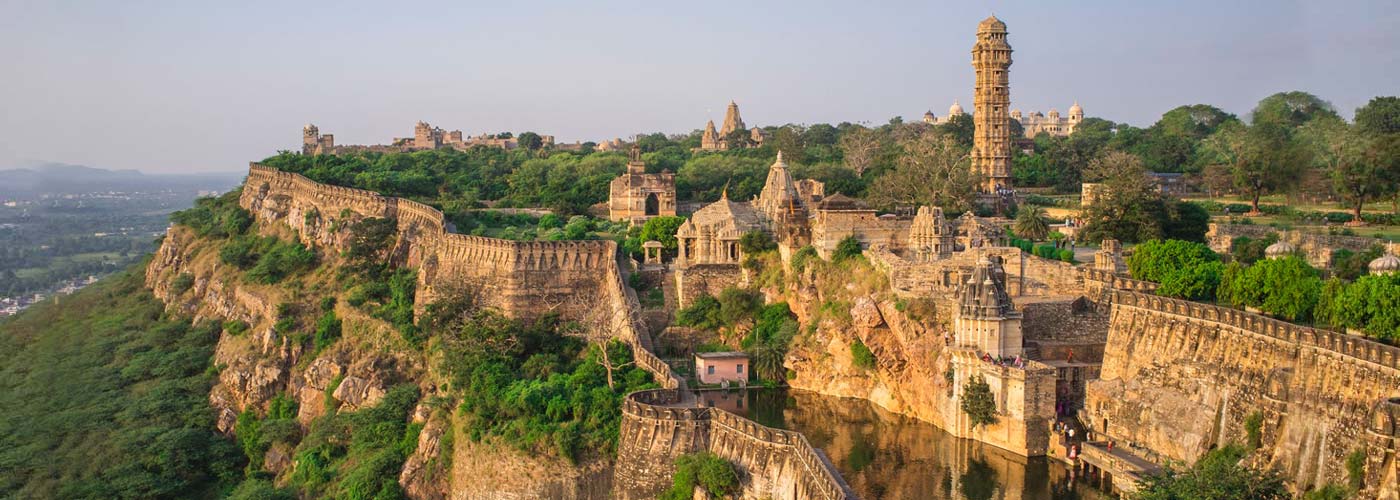History of Chittorgarh
History of Chittorgarh is one of the most stirring chapters in Indian history for it was there that the flower of Rajput chivalry sprang to life and the immense stretch of its sacred walls and ruined palaces relate the saga of innumerable sieges and heroism which has almost become a myth now.
Chittorgarh was one of the most fiercely contested seats of power in India. With its formidable fortifications, Bappa Rawal, the legendary founder of the Sisodia dynasty, received Chittor in the middle of the eighth century, as part of the last Solanki princess's dowry. It crowns a seven-mile- long hill, covering 700 acres (280 hectares), with its fortifications, temples, towers and palaces.
From the eighth to the 16th century, Bappa Rawal's descendants ruled over an important kingdom called Mewar stretching from Gujarat to Ajmer. But during these eight centuries the seemingly impregnable Chittor was surrounded, overrun, and sacked three times.
In 1303 Allauddin khilji, Sultan of Delhi, intrigued by tales of the matchless beauty of Padmini, Rani of Chittor, of her wit and charm, decided to verify this himself. His armies surrounded Chittor, and the sultan sent a message to Rana Rattan Singh, Padmini's husband, to say that he would spare the city if he could meet its famous queen. The compromise finally reached was that the sultan could look upon Padmini's reflection if he came unarmed into the fort. Accordingly, the sultan went up the hill and glimpsed a reflection of the beautiful Padmini standing by a lotus pool. He thanked his host who courteously escorted Allauddin down to the outer gate-where the sultan's men waited in ambush to take the rana hostage.
There was consternation in Chittor until Padmini devised a plan. A messenger informed the sultan that the rani would come to him. Dozens of curtained palanquins set off down the hill, each carried by six humble bearers. Once inside the Sultan's camp, four well-armed Rajput warriors leaped out of each palanquin and each lowly palanquin bearer drew a sword.In the ensuing battle, Rana Rattan Singh was rescued-but 7,000 Rajput warriors died. The sultan now attacked Chittor with renewed vigor. Having lost 7,000 of its best warriors, Chittor could not hold out. Surrender was unthinkable. The rani and her entire entourage of women, the wives of generals and soldiers, sent their children into hiding with loyal retainers. They then dressed their wedding fine , slid their farewells, and singing ancient hymns, boldly entered the mahal and performed jauhar.
The men, watching with expressionless faces, then donned saffron robes, smeared the holy ashes of their women on their foreheads, flung open the gates of the fort and thundered down the hill into the enemy ranks, to fight to the death.The second sack or shake (sacrifice) of Chittor, by which Rajputs still swear when pledging their word, occurred in 1535, when Sultan Bahadur Shan Of Gujarat attacked the fort.
History of the Fort
In ancient India, the place where the fort is currently present was known as Chitrakut. Due to the ancientness of this fort, there are no clear evidences supporting the origin of the fort. There is however, a bunch of theories that are still subjected to debates. The most common theory states that Chitrangada Mori, a local Maurya ruler built the fort. A water body which was situated next to the fort is said to have been created by the legendary hero of Mahabharata, Bhima. The legend has it that Bhima once struck the ground with all his might, which gave rise to a huge reservoir. Bhimlat Kund, an artificial tank next to the fort, was where the legendary reservoir once sat, it is said.
Thanks to the fort’s majestic appearance, many rulers in the past have tried to capture it, in an attempt to make it their own. Bappa Rawal of the Guhila dynasty was one of the earliest rulers to have captured the fort successfully. It is said that the fort was captured by him around 730 AD, after defeating the Moris, to whom the fort once belonged. Another version of the story states that Bappa Rawal did not capture the fort from the Moris but from the Arabs, who had captured it from the Moris, even before the arrival of Bappa Rawal. It is said that Bappa Rawal was part of the army led by Nagabhata I of the Gurjara Pratihara dynasty. It is believed that this army was mighty enough to defeat the famous troops of Arab, who were considered imperious on a battle field back then. Another legend has it that the fort was given as part of dowry to Bappa Rawal by the Moris, when they gave the hand of one of their princesses in marriage to Bappa Rawal.
The Conquest of Alauddin Khilji
The fort remained with the rulers of the Guhila dynasty for a long period of time until 1303, when the ruler of Delhi Sultanate Alauddin Khilji decided to capture it. He took over the ownership of the fort from King Ratnasimha after a siege that lasted for about eight months. This conquest is associated with massacre and bloodshed as many believe that Alauddin Khilji ordered the execution of more than 30,000 Hindus after capturing the fort. Another famous legend states that the fort was captured by Khilji in an attempt to force Padmini, the queen of Ratnasimha, into an extra marital relationship. This motive of Khiljiis said to have resulted in the mass self-immolation (jauhar) of Chittorgarh women, led by Queen Padmini. A few years later, Alauddin Khilji passed on the fort to his son Khizr Khan, who possessed it until 1311 AD.
 +91 9799050299
+91 9799050299 

